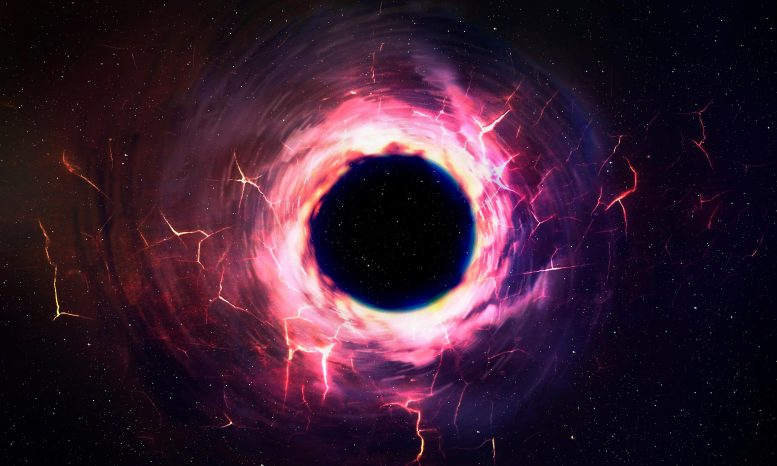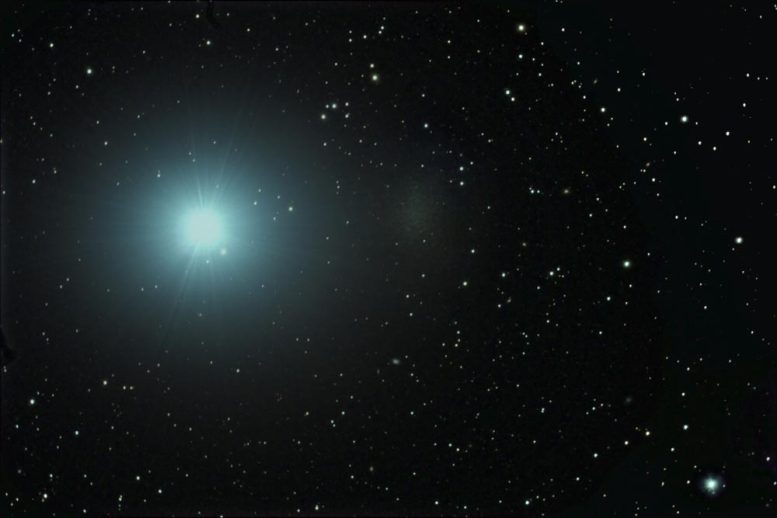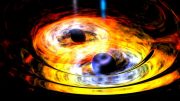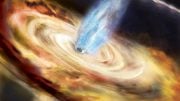
Astrophysicists have devised a new way to verify the existence of the supermassive black hole Leo I*.
A behemoth black hole, as massive as the one at the center of the Milky Way, is hosted by a dwarf galaxy less than 1 million light-years away. Invisible so far — maybe not for long.
A way to observe what could be the second-closest supermassive black hole to Earth has been suggested by two astrophysicists at the Center for Astrophysics | Harvard & Smithsonian (CfA). This black hole is a behemoth that is 3 million times the mass of the Sun and hosted by the dwarf galaxy Leo I.
The supermassive black hole, labeled Leo I*, was first proposed by an independent team of astronomers in late 2021. The team noticed stars picking up speed as they approached the center of the galaxy — evidence for a black hole — but directly imaging emission from the black hole was not possible.
Now, a new way to verify the supermassive black hole’s existence has been suggested by CfA astrophysicists Fabio Pacucci and Avi Loeb. Their work is described in a study that was published recently in The Astrophysical Journal Letters.

The ultra-faint Milky Way companion galaxy Leo I appears as a faint patch to the right of the bright star, Regulus. Credit: Scott Anttila Anttler
“Black holes are very elusive objects, and sometimes they enjoy playing hide-and-seek with us,” says Fabio Pacucci, lead author of the ApJ Letters study. “Rays of light cannot escape their event horizons, but the environment around them can be extremely bright — if enough material falls into their gravitational well. But if a black hole is not accreting mass, instead, it emits no light and becomes impossible to find with our telescopes.”
This is the challenge with Leo I — a dwarf galaxy so devoid of gas available to accrete that it is often described as a “fossil.” So, shall we relinquish any hope of observing it? Perhaps not, the astronomers say.
“In our study, we suggested that a small amount of mass lost from stars wandering around the black hole could provide the accretion rate needed to observe it,” Pacucci explains. “Old stars become very big and red — we call them red giant stars. Red giants typically have strong winds that carry a fraction of their mass to the environment. The space around Leo I* seems to contain enough of these ancient stars to make it observable.”
“Observing Leo I* could be groundbreaking,” says Avi Loeb, the co-author of the study. “It would be the second-closest supermassive black hole after the one at the center of our galaxy, with a very similar mass but hosted by a galaxy that is a thousand times less massive than the Milky Way. This fact challenges everything we know about how galaxies and their central supermassive black holes co-evolve. How did such an oversized baby end up being born from a slim parent?”
Decades of studies show that most massive galaxies host a supermassive black hole at their center, and the mass of the black hole is a tenth of a percent of the total mass of the spheroid of stars surrounding it.
“In the case of Leo I,” Loeb continues, “we would expect a much smaller black hole. Instead, Leo I appears to contain a black hole a few million times the mass of the Sun, similar to that hosted by the Milky Way. This is exciting because science usually advances the most when the unexpected happens.”
So, when can we expect an image of the black hole?
“We are not there yet,” Pacucci says.
The team has obtained telescope time on the space-borne Chandra X-ray Observatory and the Very Large Array radio telescope in New Mexico and is currently analyzing the new data.
Pacucci says, “Leo I* is playing hide-and-seek, but it emits too much radiation to remain undetected for long.”
Reference: “Accretion from Winds of Red Giant Branch Stars May Reveal the Supermassive Black Hole in Leo I” by Fabio Pacucci and Abraham Loeb, 28 November 2022, The Astrophysical Journal Letters.
DOI: 10.3847/2041-8213/ac9b21









The lingering question of how Leo1* got so big from a slender parent- a naive answer would be that it had already finished accreting all of the available material millions of years ago. Hence an area with very little surrounding material and a big ‘ol black hole
Please do not bombard the reader with BH nonsense before you can prove its existence with intuitive and common sense. At least, respond to the disapproving paper against the so-called supermassive BH of M87 which is actually an artifact of data processing.
Hi,
Like most of our astronomers that are saying that the universe is expanding and it’s not, because it’s like if you take a train and you go descend from a mountain and you travel in the back of the train you have the illusion that the mountains around are growing or red expanding because of the massive size of the mountains compared with the train and it is the same for the Universe that seems that it is expanding, but it is not because of the massive size of the Universe compared with the sizes of the Earth.
And the Universe as no start point and a finished point, has no beginning or end…
Is like the time and space time and space doesn’t existe, it is a creation of the human being, to have a sense of existence and orientation, that’s why we can get time travel, ways to travel across the long distances of the Universe
And we can travel at speed of the light because have this spirit of the Universe, time and space and we can’t because of this ideas we can’t accept even for our selves to create and then accept these ideas…
If you understand what I am saying you can understand what I am saying on the following:
We cannot travel at the speed of light and this never will be, because we must travel in the velocity of the light…
If you understand what I said before you understand straight away what I am saying..
You can learn these things and ideas on what happens on the Bible stories, like when one day St Anthony the Lisbon and Padua a angel appears to him and say: St Anthony your father is in trial in a Portuguese, Lisbon court and he said to the congregation that was with him at the church and he asked to them; continue to pray and I come back … and he travel in a tunnel of light inside the light and appears in Lisbon in seconds to defend his father and how it is possible travel 3 thousand kilometres in seconds on the,,13 century,there wasn’t at that time planes like we have now and how he does it?
These and many other explanations I can give you by contact me at my phone number:
0044753173 9689
Or by my email address:
[email protected]
We live in a dimension within a multiverse. Black holes are bs. As well as space. Conjured up by witches and warlocks. The word “Nasa” literally means “to decieve”. Tell me something. How is it that we are spinning and hurdling through space at millions of miles per day and yet all the constellations, planets, and moon are always where they are supposed to be every day year after year. And why hasn’t Polaris moved even an inch in recorded history.lol.
Is the sun burning through the universe as well? We live on a Flat, Stationary earth covered by the firmament. If you still believe what the Nazis at Nasa tell you, you need help. Black holes. Lololol. What you need to think about is what Nasa is spending all our money on every year. What have they actually accomplished? The only thing they have actually accomplished is the mass deception of the populous. I don’t think it costs 60 million a day or however much it is they get to pump out artist renditions of galaxies, planets and “black holes”.
Not one image of space is legit.
Mass of BlackHole mentioned 3m fold our Sum ie 6E36kg, electron Charge 1609e19Q. I think the average bod would also be interested in its Density, Diameter speculated temperature or magnetic properties etc.
Alexander Rimmer, look up, what is above, a black sheet with white dots 😆😆😆
Holy s*** the nutters on here are actually insane.
It’s impossible catch a photo of Black holes they’re absorbing mass & light
They exist only on computer